Matthew Wallingford
Beyond the Frame: Generating 360° Panoramic Videos from Perspective Videos
Apr 10, 2025Abstract:360{\deg} videos have emerged as a promising medium to represent our dynamic visual world. Compared to the "tunnel vision" of standard cameras, their borderless field of view offers a more complete perspective of our surroundings. While existing video models excel at producing standard videos, their ability to generate full panoramic videos remains elusive. In this paper, we investigate the task of video-to-360{\deg} generation: given a perspective video as input, our goal is to generate a full panoramic video that is consistent with the original video. Unlike conventional video generation tasks, the output's field of view is significantly larger, and the model is required to have a deep understanding of both the spatial layout of the scene and the dynamics of objects to maintain spatio-temporal consistency. To address these challenges, we first leverage the abundant 360{\deg} videos available online and develop a high-quality data filtering pipeline to curate pairwise training data. We then carefully design a series of geometry- and motion-aware operations to facilitate the learning process and improve the quality of 360{\deg} video generation. Experimental results demonstrate that our model can generate realistic and coherent 360{\deg} videos from in-the-wild perspective video. In addition, we showcase its potential applications, including video stabilization, camera viewpoint control, and interactive visual question answering.
From an Image to a Scene: Learning to Imagine the World from a Million 360 Videos
Dec 10, 2024Abstract:Three-dimensional (3D) understanding of objects and scenes play a key role in humans' ability to interact with the world and has been an active area of research in computer vision, graphics, and robotics. Large scale synthetic and object-centric 3D datasets have shown to be effective in training models that have 3D understanding of objects. However, applying a similar approach to real-world objects and scenes is difficult due to a lack of large-scale data. Videos are a potential source for real-world 3D data, but finding diverse yet corresponding views of the same content has shown to be difficult at scale. Furthermore, standard videos come with fixed viewpoints, determined at the time of capture. This restricts the ability to access scenes from a variety of more diverse and potentially useful perspectives. We argue that large scale 360 videos can address these limitations to provide: scalable corresponding frames from diverse views. In this paper, we introduce 360-1M, a 360 video dataset, and a process for efficiently finding corresponding frames from diverse viewpoints at scale. We train our diffusion-based model, Odin, on 360-1M. Empowered by the largest real-world, multi-view dataset to date, Odin is able to freely generate novel views of real-world scenes. Unlike previous methods, Odin can move the camera through the environment, enabling the model to infer the geometry and layout of the scene. Additionally, we show improved performance on standard novel view synthesis and 3D reconstruction benchmarks.
The Unmet Promise of Synthetic Training Images: Using Retrieved Real Images Performs Better
Jun 07, 2024Abstract:Generative text-to-image models enable us to synthesize unlimited amounts of images in a controllable manner, spurring many recent efforts to train vision models with synthetic data. However, every synthetic image ultimately originates from the upstream data used to train the generator. What additional value does the intermediate generator provide over directly training on relevant parts of the upstream data? Grounding this question in the setting of image classification, we compare finetuning on task-relevant, targeted synthetic data generated by Stable Diffusion -- a generative model trained on the LAION-2B dataset -- against finetuning on targeted real images retrieved directly from LAION-2B. We show that while synthetic data can benefit some downstream tasks, it is universally matched or outperformed by real data from our simple retrieval baseline. Our analysis suggests that this underperformance is partially due to generator artifacts and inaccurate task-relevant visual details in the synthetic images. Overall, we argue that retrieval is a critical baseline to consider when training with synthetic data -- a baseline that current methods do not yet surpass. We release code, data, and models at https://github.com/scottgeng00/unmet-promise.
Superposed Decoding: Multiple Generations from a Single Autoregressive Inference Pass
May 29, 2024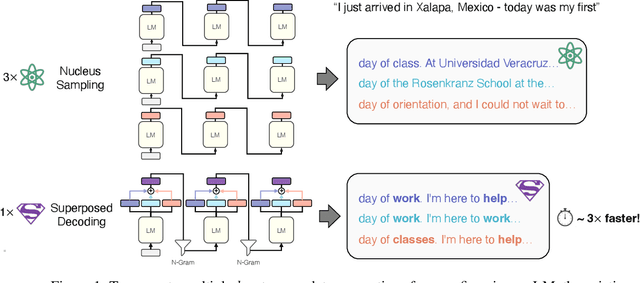

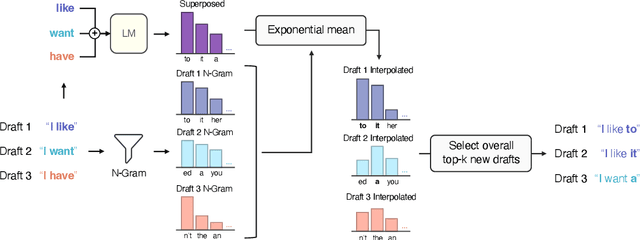

Abstract:Many applications today provide users with multiple auto-complete drafts as they type, including GitHub's code completion, Gmail's smart compose, and Apple's messaging auto-suggestions. Under the hood, language models support this by running an autoregressive inference pass to provide a draft. Consequently, providing $k$ drafts to the user requires running an expensive language model $k$ times. To alleviate the computation cost of running $k$ inference passes, we propose Superposed Decoding, a new decoding algorithm that generates $k$ drafts at the computation cost of one autoregressive inference pass. We achieve this by feeding a superposition of the most recent token embeddings from the $k$ drafts as input to the next decoding step of the language model. At every inference step we combine the $k$ drafts with the top-$k$ tokens to get $k^2$ new drafts and cache the $k$ most likely options, using an n-gram interpolation with minimal compute overhead to filter out incoherent generations. Our experiments show that $k$ drafts from Superposed Decoding are at least as coherent and factual as Nucleus Sampling and Greedy Decoding respectively, while being at least $2.44\times$ faster for $k\ge3$. In a compute-normalized setting, user evaluations demonstrably favor text generated by Superposed Decoding over Nucleus Sampling. Code and more examples open-sourced at https://github.com/RAIVNLab/SuperposedDecoding.
Multilingual Diversity Improves Vision-Language Representations
May 27, 2024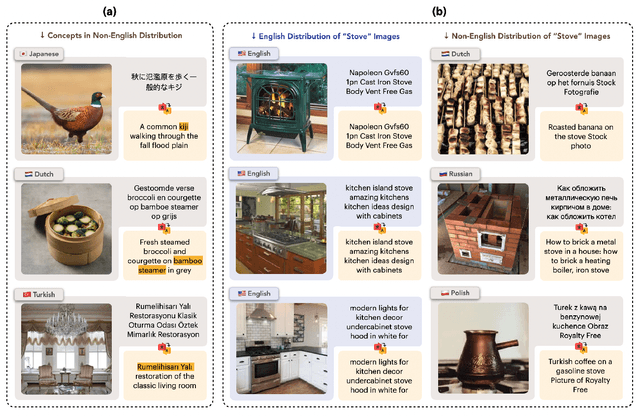
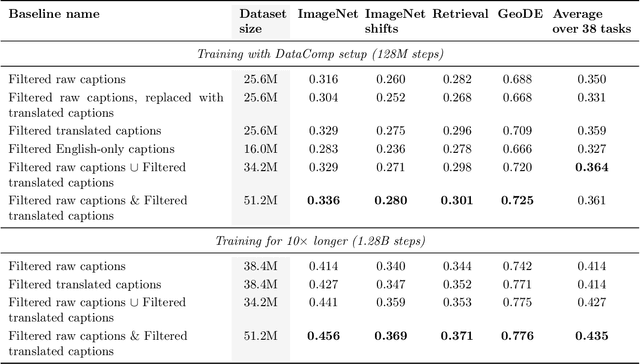
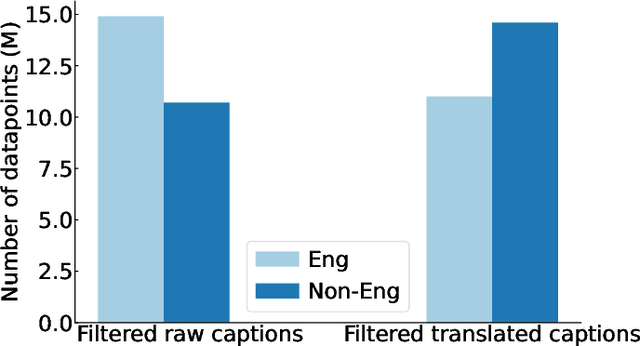
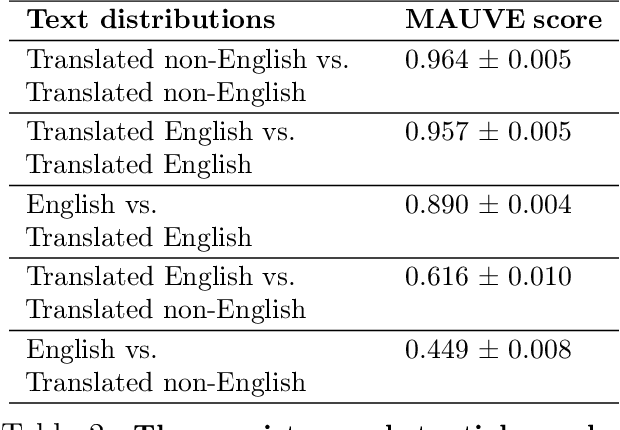
Abstract:Massive web-crawled image-text datasets lay the foundation for recent progress in multimodal learning. These datasets are designed with the goal of training a model to do well on standard computer vision benchmarks, many of which, however, have been shown to be English-centric (e.g., ImageNet). Consequently, existing data curation techniques gravitate towards using predominantly English image-text pairs and discard many potentially useful non-English samples. Our work questions this practice. Multilingual data is inherently enriching not only because it provides a gateway to learn about culturally salient concepts, but also because it depicts common concepts differently from monolingual data. We thus conduct a systematic study to explore the performance benefits of using more samples of non-English origins with respect to English vision tasks. By translating all multilingual image-text pairs from a raw web crawl to English and re-filtering them, we increase the prevalence of (translated) multilingual data in the resulting training set. Pre-training on this dataset outperforms using English-only or English-dominated datasets on ImageNet, ImageNet distribution shifts, image-English-text retrieval and on average across 38 tasks from the DataComp benchmark. On a geographically diverse task like GeoDE, we also observe improvements across all regions, with the biggest gain coming from Africa. In addition, we quantitatively show that English and non-English data are significantly different in both image and (translated) text space. We hope that our findings motivate future work to be more intentional about including multicultural and multilingual data, not just when non-English or geographically diverse tasks are involved, but to enhance model capabilities at large.
Objaverse-XL: A Universe of 10M+ 3D Objects
Jul 11, 2023Abstract:Natural language processing and 2D vision models have attained remarkable proficiency on many tasks primarily by escalating the scale of training data. However, 3D vision tasks have not seen the same progress, in part due to the challenges of acquiring high-quality 3D data. In this work, we present Objaverse-XL, a dataset of over 10 million 3D objects. Our dataset comprises deduplicated 3D objects from a diverse set of sources, including manually designed objects, photogrammetry scans of landmarks and everyday items, and professional scans of historic and antique artifacts. Representing the largest scale and diversity in the realm of 3D datasets, Objaverse-XL enables significant new possibilities for 3D vision. Our experiments demonstrate the improvements enabled with the scale provided by Objaverse-XL. We show that by training Zero123 on novel view synthesis, utilizing over 100 million multi-view rendered images, we achieve strong zero-shot generalization abilities. We hope that releasing Objaverse-XL will enable further innovations in the field of 3D vision at scale.
Neural Priming for Sample-Efficient Adaptation
Jun 24, 2023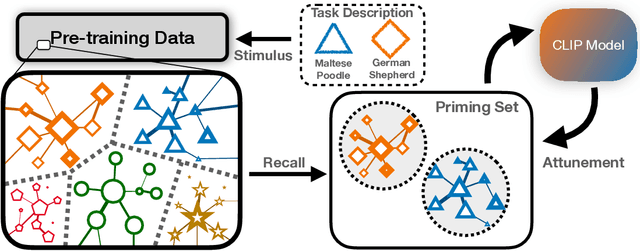

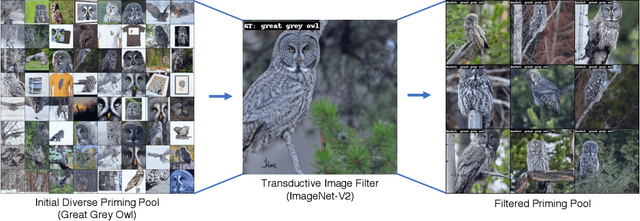

Abstract:We propose Neural Priming, a technique for adapting large pretrained models to distribution shifts and downstream tasks given few or no labeled examples. Presented with class names or unlabeled test samples, Neural Priming enables the model to recall and conditions its parameters on relevant data seen throughout pretraining, thereby priming it for the test distribution. Neural Priming can be performed at test time, even for pretraining datasets as large as LAION-2B. Performing lightweight updates on the recalled data significantly improves accuracy across a variety of distribution shift and transfer learning benchmarks. Concretely, in the zero-shot setting, we see a 2.45% improvement in accuracy on ImageNet and 3.81% accuracy improvement on average across standard transfer learning benchmarks. Further, using Neural Priming at inference to adapt to distribution shift, we see a 1.41% accuracy improvement on ImageNetV2. These results demonstrate the effectiveness of Neural Priming in addressing the challenge of limited labeled data and changing distributions. Code is available at github.com/RAIVNLab/neural-priming.
Neural Radiance Field Codebooks
Jan 10, 2023



Abstract:Compositional representations of the world are a promising step towards enabling high-level scene understanding and efficient transfer to downstream tasks. Learning such representations for complex scenes and tasks remains an open challenge. Towards this goal, we introduce Neural Radiance Field Codebooks (NRC), a scalable method for learning object-centric representations through novel view reconstruction. NRC learns to reconstruct scenes from novel views using a dictionary of object codes which are decoded through a volumetric renderer. This enables the discovery of reoccurring visual and geometric patterns across scenes which are transferable to downstream tasks. We show that NRC representations transfer well to object navigation in THOR, outperforming 2D and 3D representation learning methods by 3.1% success rate. We demonstrate that our approach is able to perform unsupervised segmentation for more complex synthetic (THOR) and real scenes (NYU Depth) better than prior methods (29% relative improvement). Finally, we show that NRC improves on the task of depth ordering by 5.5% accuracy in THOR.
Matryoshka Representations for Adaptive Deployment
Jun 01, 2022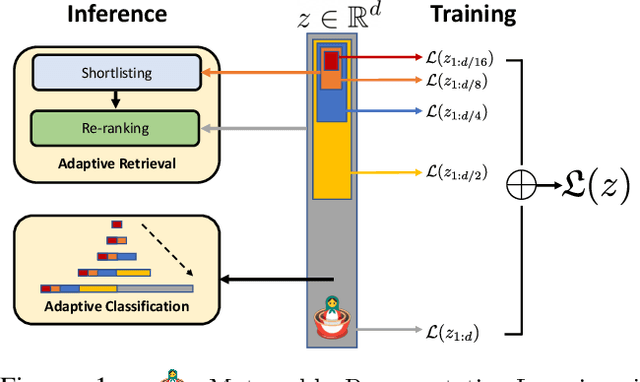
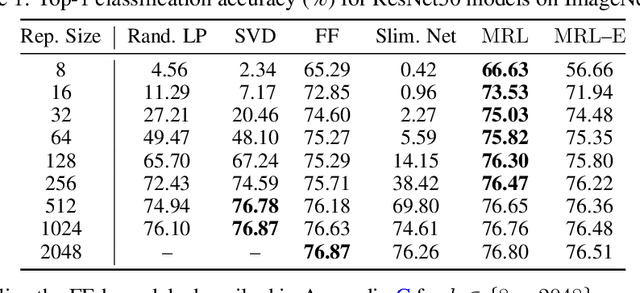
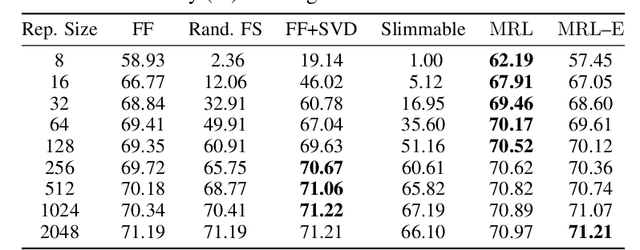
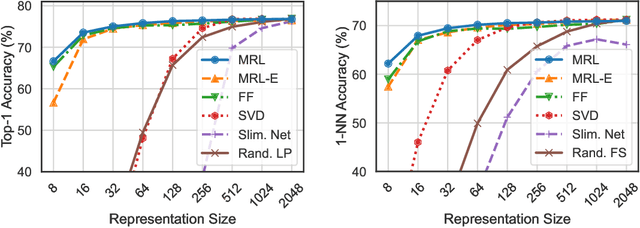
Abstract:Learned representations are a central component in modern ML systems, serving a multitude of downstream tasks. When training such representations, it is often the case that computational and statistical constraints for each downstream task are unknown. In this context rigid, fixed capacity representations can be either over or under-accommodating to the task at hand. This leads us to ask: can we design a flexible representation that can adapt to multiple downstream tasks with varying computational resources? Our main contribution is Matryoshka Representation Learning (MRL) which encodes information at different granularities and allows a single embedding to adapt to the computational constraints of downstream tasks. MRL minimally modifies existing representation learning pipelines and imposes no additional cost during inference and deployment. MRL learns coarse-to-fine representations that are at least as accurate and rich as independently trained low-dimensional representations. The flexibility within the learned Matryoshka Representations offer: (a) up to 14x smaller embedding size for ImageNet-1K classification at the same level of accuracy; (b) up to 14x real-world speed-ups for large-scale retrieval on ImageNet-1K and 4K; and (c) up to 2% accuracy improvements for long-tail few-shot classification, all while being as robust as the original representations. Finally, we show that MRL extends seamlessly to web-scale datasets (ImageNet, JFT) across various modalities -- vision (ViT, ResNet), vision + language (ALIGN) and language (BERT). MRL code and pretrained models are open-sourced at https://github.com/RAIVNLab/MRL.
Task Adaptive Parameter Sharing for Multi-Task Learning
Mar 30, 2022
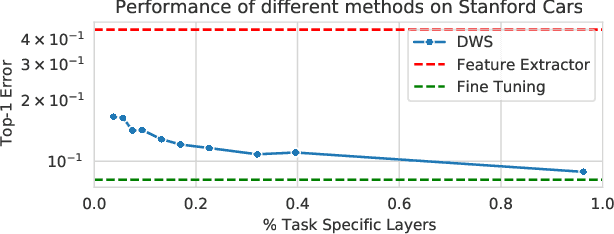
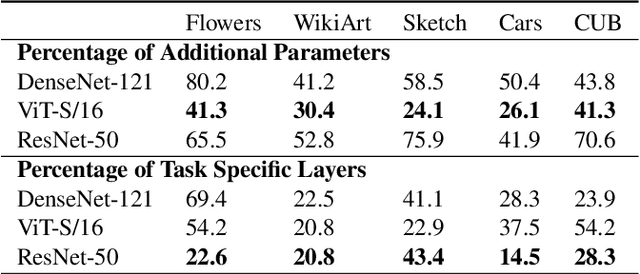
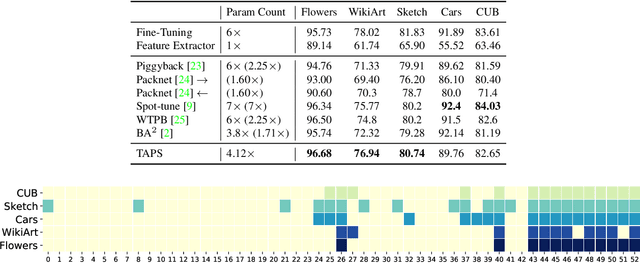
Abstract:Adapting pre-trained models with broad capabilities has become standard practice for learning a wide range of downstream tasks. The typical approach of fine-tuning different models for each task is performant, but incurs a substantial memory cost. To efficiently learn multiple downstream tasks we introduce Task Adaptive Parameter Sharing (TAPS), a general method for tuning a base model to a new task by adaptively modifying a small, task-specific subset of layers. This enables multi-task learning while minimizing resources used and competition between tasks. TAPS solves a joint optimization problem which determines which layers to share with the base model and the value of the task-specific weights. Further, a sparsity penalty on the number of active layers encourages weight sharing with the base model. Compared to other methods, TAPS retains high accuracy on downstream tasks while introducing few task-specific parameters. Moreover, TAPS is agnostic to the model architecture and requires only minor changes to the training scheme. We evaluate our method on a suite of fine-tuning tasks and architectures (ResNet, DenseNet, ViT) and show that it achieves state-of-the-art performance while being simple to implement.
 Add to Chrome
Add to Chrome Add to Firefox
Add to Firefox Add to Edge
Add to Edge